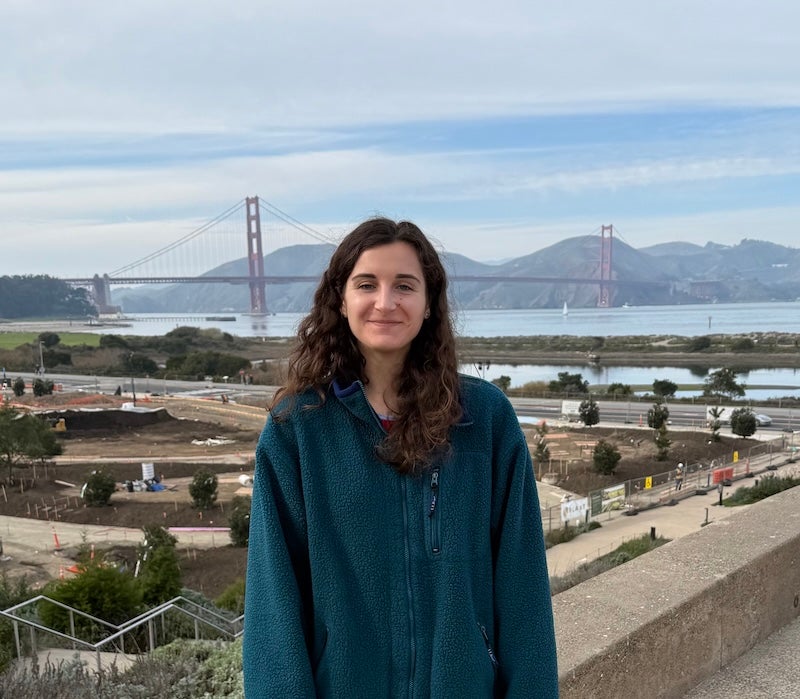Geographic information systems, or GIS, is a type of computer system or program software that is used to store, analyze, manage, and visualize geographic information. Its applications are varied, and it is used in a variety of scientific fields. At URI, GIS is used to manage the impressive botanical collections on the Kingston Campus. What started as a need for better organization of the accessions database – a spreadsheet that tracked the inventory of plants housed on campus – grew into an interactive tool used by both staff and visitors alike: URI Botanical Collections Database.
The leading developer for the database was GIS and spatial services specialist Meagan Shanaghan ‘20 M.E.S.M. ‘23. Elizabeth Leibovitz, garden coordinator for URI’s Youngken Medicinal Garden, and Allegra Halverson, assistant manager of University farms, wanted a way to organize the more than 1,200 species and cultivars in inventory and share details about each of the plants with visitors who come to the Youngken Medicinal Garden, Horridge Conservatory, and URI Greenhouses. They approached the GIS and Spatial Services office, where they worked with Shanaghan on developing a new database for inventory management.
“Allegra and Liz approached my office because they were having trouble with the current database software to manage the collections data,” Shanaghan says. “It was too robust and clunky for their needs, so they wanted a different solution. As part of the facilities group at URI, we have taken the lead on management GIS for the facilities side of the University, separate from the student side of things.” Luckily for the team, GIS was the perfect solution for their resource management needs, providing a spatial component that allows staff to look at the accessions data on a map and see exactly where each plant is located on campus.
Shanaghan, who started her GIS work when taking NRS 410: Fundamentals of GIS, was able to apply the foundational concepts she learned to her first job while at URI. It was through her summer job mapping invasive plants that she grew more interested in its practical applications. “I worked for a land trust in Maine, and I used GIS to map where invasive plants were located on the land trust properties,” she says. “It was quite a coincidence that my first practical application was actually mapping plants. I then decided to enroll in the MESM program, and that’s where my formal education in GIS began.” She notes that NRS 410 taught her many key concepts that tied directly into projects like the Botanical Collections Database, as well as other projects she works on for the University.
The Botanical Collections Database was a project started two years ago, with some trial and error to figure out the best way to sort, manage, and publish the data about the botanical collections. “When we first began, I published their data as a hosted feature layer on our GIS portal, which worked at first,” Shanaghan says. “However, it eventually didn’t work anymore because the team wanted to do certain things that could only be accomplished if the data was housed in a management portal, like a Sequel server. They wanted to have fields that could calculate different data for attribute rules. One of the biggest challenges was understanding how to change where their data was housed, but luckily I had help with that.”
For students interested in learning more about GIS or considering a career within GIS and spatial services, Shanaghan recommends taking plenty of GIS courses and reaching out to professors. “I took all of the GIS courses at URI and they were awesome, especially Dr. Parent’s classes,” she says. “I also took Dr. Andrew Davies’ Python course, which was eye-opening for what you can do with GIS when working with really large datasets, and it gives an introduction to coding.” Shanaghan notes that she also reached out to people across the state to seek out and learn more about opportunities for working with GIS: “I sent a lot of emails to different cities and towns in Rhode Island to see if they needed help with GIS programs. I had a lot of helpful interviews and meetings. Many cities and towns are starting to want to use GIS to catalog their resources, such as utilities and parcel boundaries. I’d say just reach out to people, and don’t be afraid to send emails to people you’re interested in working with.”
This story was written by Yvonne Wingard, Communications Fellow in the College of the Environment and Life Sciences.

